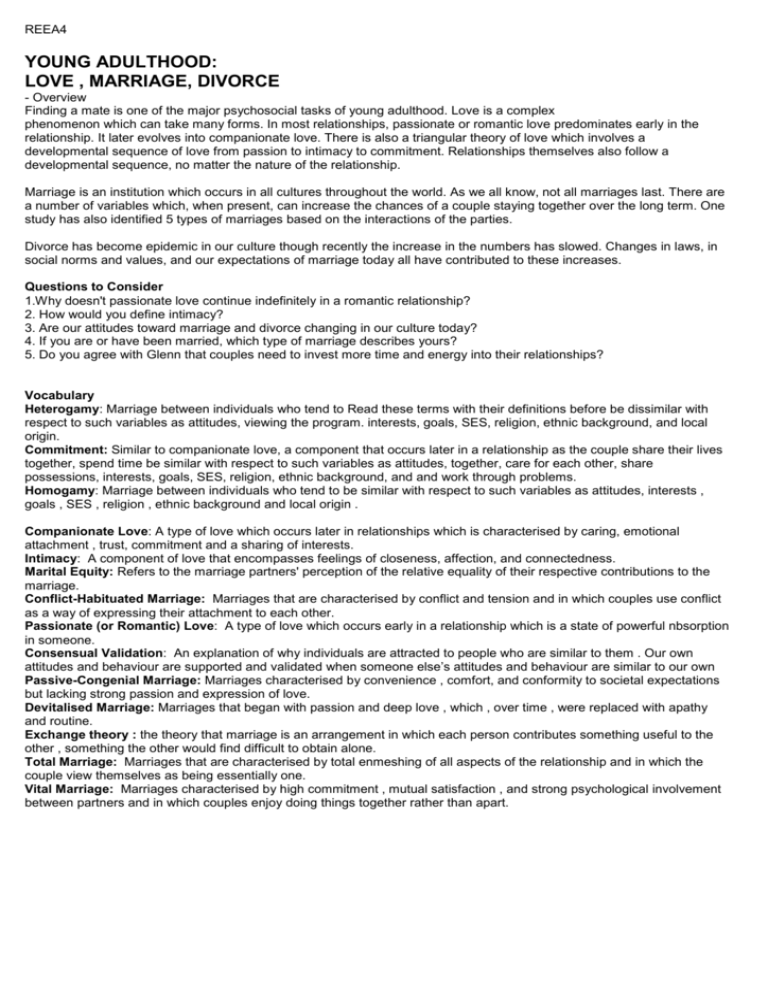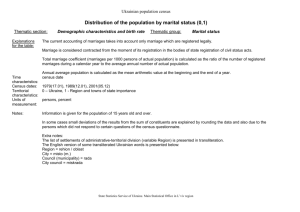YOUNG ADULTHOOD: LOVE , MARRIAGE, DIVORCE
advertisement

REEA4 YOUNG ADULTHOOD: LOVE , MARRIAGE, DIVORCE - Overview Finding a mate is one of the major psychosocial tasks of young adulthood. Love is a complex phenomenon which can take many forms. In most relationships, passionate or romantic love predominates early in the relationship. It later evolves into companionate love. There is also a triangular theory of love which involves a developmental sequence of love from passion to intimacy to commitment. Relationships themselves also follow a developmental sequence, no matter the nature of the relationship. Marriage is an institution which occurs in all cultures throughout the world. As we all know, not all marriages last. There are a number of variables which, when present, can increase the chances of a couple staying together over the long term. One study has also identified 5 types of marriages based on the interactions of the parties. Divorce has become epidemic in our culture though recently the increase in the numbers has slowed. Changes in laws, in social norms and values, and our expectations of marriage today all have contributed to these increases. Questions to Consider 1.Why doesn't passionate love continue indefinitely in a romantic relationship? 2. How would you define intimacy? 3. Are our attitudes toward marriage and divorce changing in our culture today? 4. If you are or have been married, which type of marriage describes yours? 5. Do you agree with Glenn that couples need to invest more time and energy into their relationships? Vocabulary Heterogamy: Marriage between individuals who tend to Read these terms with their definitions before be dissimilar with respect to such variables as attitudes, viewing the program. interests, goals, SES, religion, ethnic background, and local origin. Commitment: Similar to companionate love, a component that occurs later in a relationship as the couple share their lives together, spend time be similar with respect to such variables as attitudes, together, care for each other, share possessions, interests, goals, SES, religion, ethnic background, and and work through problems. Homogamy: Marriage between individuals who tend to be similar with respect to such variables as attitudes, interests , goals , SES , religion , ethnic background and local origin . Companionate Love: A type of love which occurs later in relationships which is characterised by caring, emotional attachment , trust, commitment and a sharing of interests. Intimacy: A component of love that encompasses feelings of closeness, affection, and connectedness. Marital Equity: Refers to the marriage partners' perception of the relative equality of their respective contributions to the marriage. Conflict-Habituated Marriage: Marriages that are characterised by conflict and tension and in which couples use conflict as a way of expressing their attachment to each other. Passionate (or Romantic) Love: A type of love which occurs early in a relationship which is a state of powerful nbsorption in someone. Consensual Validation: An explanation of why individuals are attracted to people who are similar to them . Our own attitudes and behaviour are supported and validated when someone else’s attitudes and behaviour are similar to our own Passive-Congenial Marriage: Marriages characterised by convenience , comfort, and conformity to societal expectations but lacking strong passion and expression of love. Devitalised Marriage: Marriages that began with passion and deep love , which , over time , were replaced with apathy and routine. Exchange theory : the theory that marriage is an arrangement in which each person contributes something useful to the other , something the other would find difficult to obtain alone. Total Marriage: Marriages that are characterised by total enmeshing of all aspects of the relationship and in which the couple view themselves as being essentially one. Vital Marriage: Marriages characterised by high commitment , mutual satisfaction , and strong psychological involvement between partners and in which couples enjoy doing things together rather than apart. Instructional Objectives When you have successfully completed this module, you will be able to: 1. Discuss why we often are attracted to people who are like us; define consensual validation 2. Describe the developmental sequence of love and its various types. 3. Describe the developmental sequence that occurs in relationships. 4. Identify the factors that are related to marital success. 5. Describe the 5 types of marriages. 6. Discuss why divorce has increased so dramatically in our society over the last 30 years. Self- Test After studying the objectives and watching the video, take the self-test to check your progress. Consensual validation refers to the fact that we tend to associate with people who ______________________ 2. Jim and Margaret have been married for 35 years. They share deep intimacy and commitment but are not longer passionate. Their love is now ____a. fatuous. .___ b. empty. ____c. companionate. .d. consummate. 3. When we compare Ryan and Barbara, a married couple, with Stan and Brett, a homosexual couple, we find that as the years pass ____a. both couples will experience a fading of passion and the development of commitment. ____b. only Ryan and Barbara will experience growth of commitment. ____c. Ryan and Barbara will have more passion; Stan and Brett will have more intimacy. ____d. both couples will experience an increase in intimacy and a stabilisation of passion. 4. Erikson believes that a healthy intimacy in marriage is more likely to emerge when ____a. neither partner has yet established a sense of identity. ____b. both partners have established a sense of identity. ____c. one partner has established a sense of identity and the other fits in. ____d. the couple has several children. 5. In a series of seven studies of college students, those who were less advanced on a measure based on Erikson's identity and intimacy tended to define love in terms of ____a. intimacy. ____b. commitment. ____c. passion. ____d. identity. 6. Marriages between people of different social backgrounds is called ____a. heterosexuality ____b. heterogamy ____c. homogamy ____d. role incompatibility 7. The view that marriage is an arrangement in which each partner contributes something useful to the other, something the other would find difficult to attain alone, is part of the ____a. equity theory. ____b. equality theory. ____c. complementary theory. ____d. exchange theory. 8. Compared with couples today, couples in earlier decades ____a. expected to really understand each other. ____b. based marital equity on firm gender roles. ____c. expected each other to be both a friend and a lover. ____d. saw little difference between masculinity and femininity 9. Equity in today's marriages ____a. involves work roles only. ____b. is gender specific. ____c. applies to all aspects of marriage, including wage earning, domestic work, and sexual and emotional areas. ____d. is achieved early and easily. 10. List the three factors that have been found to be related to marital success a. b. c. 11. Place the letter of the correct definition next to the name of the type of marriage. ____Vital Marriage ____Devitalised Marriage ____Passive-Congenial Marriage ____Total Marriage ____Conflict-Habituated Marriage a. Marriages characterised by convenience, comfort, and conformity to societal expectations but lacking strong passion and expressions of love. b. Marriages that are characterised by conflict and tension and in which couples use conflict as a way of expressing their attachment to each other. c. Marriages characterised by high commitment, mutual satisfaction, and strong psychological involvement between partners and in which couples enjoy doing things together rather than apart. d. Marriages that began with passion and deep love, which, over time, were replaced by apathy and routine. e. Marriages that are characterised by total enmeshing of all aspects of the relationship and in which the couple view themselves as being essentially one. 12. Identify three reasons why the divorce rate has increased in our society. a. b. c. 1.are like us in their attitudes and behaviours. 2. c 3. a 4. b 5. c 6. b 7. d 8. b 9. c 10. a. age b. homogamy c. marital equity 11. c d a e b 12. a. changes in laws b. changes in social norms c. expectations of marriage partner





